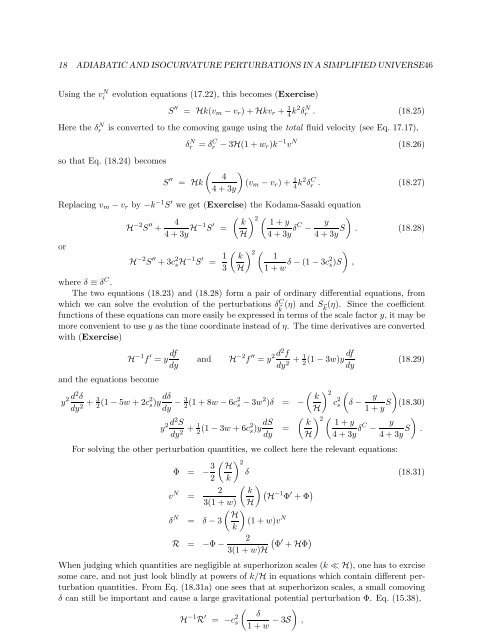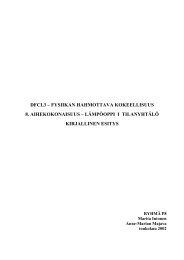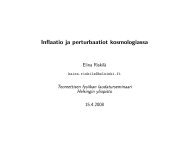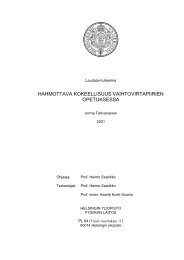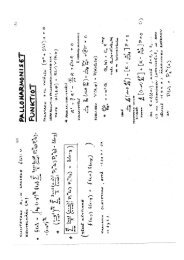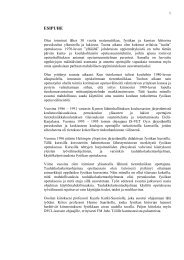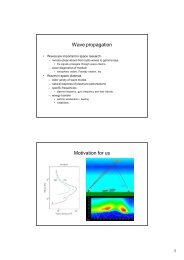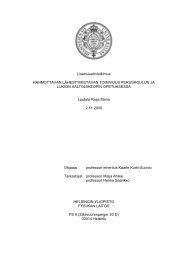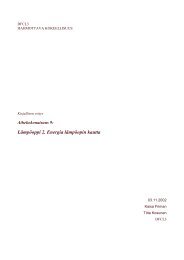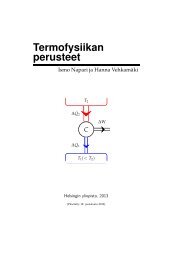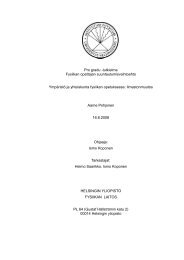Cosmological Perturbation Theory, 26.4.2011 version
Cosmological Perturbation Theory, 26.4.2011 version
Cosmological Perturbation Theory, 26.4.2011 version
You also want an ePaper? Increase the reach of your titles
YUMPU automatically turns print PDFs into web optimized ePapers that Google loves.
18 ADIABATIC AND ISOCURVATURE PERTURBATIONS IN A SIMPLIFIED UNIVERSE46Using the v N ievolution equations (17.22), this becomes (Exercise)S ′′ = Hk(v m − v r ) + Hkv r + 1 4 k2 δ N r . (18.25)Here the δ N r is converted to the comoving gauge using the total fluid velocity (see Eq. 17.17),so that Eq. (18.24) becomesS ′′δ N r = δ C r − 3H(1 + w r)k −1 v N (18.26)( ) 4= Hk (v m − v r ) + 14 + 3y4 k2 δr C . (18.27)Replacing v m − v r by −k −1 S ′ we get (Exercise) the Kodama-Sasaki equationH −2 S ′′ + 4 ( ) k 2 ( 1 + y4 + 3y H−1 S ′ =H 4 + 3y δC − y )4 + 3y S . (18.28)orH −2 S ′′ + 3c 2 s H−1 S ′ = 1 ( ) k 2 ( )13 H 1 + w δ − (1 − 3c2 s )S ,where δ ≡ δ C .The two equations (18.23) and (18.28) form a pair of ordinary differential equations, fromwhich we can solve the evolution of the perturbations δ C ⃗ k(η) and S ⃗k (η). Since the coefficientfunctions of these equations can more easily be expressed in terms of the scale factor y, it may bemore convenient to use y as the time coordinate instead of η. The time derivatives are convertedwith (Exercise)H −1 f ′ = y dfdyand the equations becomey 2 d2 δdy 2 + 3 2 (1 − 5w + 2c2 s)y dδandH −2 f ′′ = y 2d2 fdy 2 + 1 df2(1 − 3w)ydy( kdy − 3 2 (1 + 8w − 6c2 s − 3w 2 )δ = −Hy 2d2 Sdy 2 + 1 2 (1 − 3w + 6c2 s)y dS ( k=dy H(18.29)) 2 (c 2 s δ −y )1 + y S (18.30)) 2 ( 1 + y4 + 3y δC − y )4 + 3y S .For solving the other perturbation quantities, we collect here the relevant equations:Φ = − 3 ( ) H 2δ (18.31)2 k( )v N 2 k (H=−1 Φ ′ + Φ )3(1 + w) H( ) Hδ N = δ − 3 (1 + w)v NkR= −Φ −2 (Φ ′ + HΦ )3(1 + w)HWhen judging which quantities are negligible at superhorizon scales (k ≪ H), one has to exrcisesome care, and not just look blindly at powers of k/H in equations which contain different perturbationquantities. From Eq. (18.31a) one sees that at superhorizon scales, a small comovingδ can still be important and cause a large gravitational potential perturbation Φ. Eq. (15.38),( ) δH −1 R ′ = −c 2 s1 + w − 3S ,


